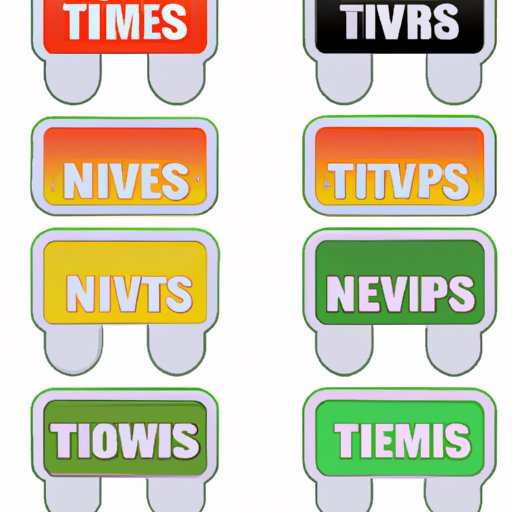Introduction
There’s nothing more frustrating than trying to remove a sticker, only to be left with a sticky residue that just won’t budge. And whether it’s on your furniture, your car, or your clothes, sticker residue can be a real eyesore. But don’t worry – there are several easy and effective ways to remove sticker residue from any surface. In this article, we’ll cover five methods that are sure to work, as well as some tips and tricks for removing even the most stubborn residue.
5 Easy and Effective Ways to Remove Sticker Residue from Any Surface
If you’re dealing with sticker residue, here are five methods you can try:
Method 1: Oil-based solvents (e.g. cooking oil or rubbing alcohol)
Oil-based solvents are great for breaking down adhesive, making them a popular choice for removing sticker residue. Cooking oil or rubbing alcohol are both effective options. Simply apply a small amount to a clean cloth and rub the residue until it comes off. For tougher residue, you may need to let the solvent sit for a few minutes before wiping it away.
Method 2: Heat (e.g. using a blow dryer or hot water)
Heat can also help loosen sticker residue, making it easier to remove. You can use a blow dryer to warm up the residue, or soak the surface in hot water for a few minutes. Once the adhesive has softened, you can use a cloth or scraper to gently remove it.
Method 3: Adhesive remover products (e.g. Goo Gone or WD-40)
Adhesive remover products are specifically designed to remove sticky residue, making them a reliable and easy-to-use option. Popular products like Goo Gone or WD-40 can be found at most hardware and home improvement stores. Simply apply the product to a cloth and wipe away the residue.
Method 4: Natural solvents (e.g. vinegar or baking soda)
If you prefer to use natural, chemical-free solutions, vinegar or baking soda can be effective at removing sticker residue. Mix equal parts of vinegar and water, or baking soda and water, and apply the solution to a cloth. Rub the residue until it comes off.
Method 5: Mechanical methods (e.g. scraping or sanding)
For tougher, more stubborn residue, you may need to resort to mechanical methods like scraping or sanding. However, it’s important to exercise caution when using these methods to avoid damaging the surface underneath. Use a plastic scraper or sandpaper with a gentle touch, and only as a last resort.
Say Goodbye to Stubborn Sticker Residue with These Simple Methods
While all of these methods can be effective, some are better suited to certain types of residue than others. Oil-based solvents and adhesive remover products are particularly useful for removing stubborn residue, while heat and natural solvents may work better for lighter residue. When using mechanical methods, be especially careful not to apply too much pressure or damage the surface underneath.
Removing Sticker Residue: Tried and Tested Techniques You Need to Know
Here are a few additional tips and tricks that can help make removing sticker residue a breeze:
- Use a credit card to gently scrape off residue on delicate surfaces
- Apply a small amount of petroleum jelly to the residue and let it sit for a few minutes before wiping it away
- Test any solvent or product on a small, inconspicuous area first to ensure that it won’t damage the surface
- Be patient – depending on the type of residue and the surface it’s on, it may take a few attempts to completely remove it
The Ultimate Guide to Removing Sticker Residue from Different Surfaces
While the methods we’ve covered so far can work on a wide variety of surfaces, here are a few specifics:
Glass
For glass surfaces, heat and natural solvents like vinegar can be particularly effective. Use a blow dryer to warm up the residue, or mix equal parts of vinegar and water and apply the solution to the residue, then wipe it away.
Plastic
Plastic surfaces can be sensitive to certain solvents, so it’s important to test any product on a small area first. Oil-based solvents or adhesive remover products are generally safe to use on plastic, but be sure to avoid using sandpaper or anything abrasive.
Wood
When removing residue from wood, heat or natural solvents should be your first choice. For tougher residue, try mixing equal parts of vegetable oil and baking soda into a paste, then apply the paste to the residue and let it sit for a few minutes before wiping it away.
Fabric
Removing sticker residue from fabric can be a bit trickier, as many solvents can be harmful to the material. Try using a solvent specifically designed for fabrics, like hairspray or rubbing alcohol. Apply the solvent to a cloth and gently wipe the residue until it comes off.
Unstick It: How to Remove Sticker Residue Without Ruining Your Belongings
The key to removing sticker residue without damaging your belongings is to be gentle. Avoid using anything abrasive or too much pressure, and test any solvent or product on a small area first. A soft cloth or sponge is generally safe to use on most surfaces. Remember – with a little patience and the right method, even the most stubborn sticker residue can be removed without ruining your belongings.
Conclusion
Sticker residue can be a real headache, but with these five methods and some extra tips and tricks, you’ll be able to remove it from any surface. Remember to be patient and cautious, especially with delicate surfaces, and test any solvents or products on a small area first.
